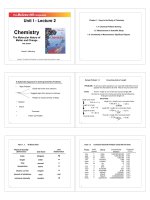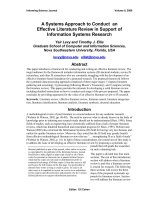Site Analysis: A Contextual Approach to Sustainable Land Planning and Site Design
Bạn đang xem bản rút gọn của tài liệu. Xem và tải ngay bản đầy đủ của tài liệu tại đây (16.63 MB, 386 trang )
ii
Site Analysis
i
ii
Site Analysis
A Contextual Approach
to Sustainable Land Planning
and Site Design
Second Edition
James A. LaGro Jr.
John Wiley & Sons, Inc.
iii
100%
TOTAL RECYCLED PAPER
100% POSTCONSUMER PAPER
This book is printed on acid-free paper. *
1
Copyright # 2008 by John Wiley & Sons, Inc. All rights reserved
Published by John Wiley & Sons, Inc., Hoboken, New Jersey
Published simultaneously in Canada
Wiley Bicentennial Logo: Richard J. Pacifico.
No part of this publication may be reproduced, stored in a retr ieval system, or transmitted in
any form or by any means, electronic, mechanical, photocopying, recording, scanning, or
otherwise, except as permitted under Section 107 or 108 of the 1976 United States Copyright
Act, without either the prior written permission of the Publisher, or authorization through
payment of the appropriate per-copy fee to the Copyright Clearance Center, 222 Rosewood
Drive, Danvers, MA 01923, (978) 750-8400, fax (978) 646-8600, or on the web at
www.copyright.com. Requests to the Publisher for permission should be addressed to the
Permissions Department, John Wiley & Sons, Inc., 111 River Street, Hoboken, NJ 07030,
(201) 748-6011, fax (201) 748-6008, or online at www.wiley.com/go/permissions.
Limit of Liability/Disclaimer of War ranty: While the publisher and the author have used their
best efforts in preparing this book, they make no representations or warranties with respect to
the accuracy or completeness of the contents of this book and specifically disclaim any implied
warranties of merchantability or fitness for a particular purpose. No warranty may be created or
extended by sales representatives or written sales materials. The advice and strategies contained
herein may not be suitable for your situation. You should consult with a professional where
appropriate. Neither the publisher nor the author shall be liable for any loss of profit or any
other commercial damages, including but not limited to special, incidental, consequential, or
other damages.
For general information about our other products and services, please contact our Customer
Care Department within the United States at (800) 762-2974, outside the United States at
(317) 572-3993 or fax (317) 572-4002.
Wiley also publishes its books in a variety of electronic formats. Some content that appears in
print may not be available in electronic books. For more information about Wiley products,
visit our web site at www.wiley.com.
Library of Congress Cataloging-in-Publication Data:
LaGro, James A.
Site analysis : a contextual approach to sustainable land planning and site design / James A.
LaGro, Jr.—2nd ed.
p. cm.
First ed. published 2001.
Includes bibliographical references and index.
ISBN 978-0-471-79798-2 (cloth)
1. Building sites—Planning. 2. Building sites—Environmental aspects.
3. Land use—Planning. 4. Land use—Environmental aspects. I. Title.
NA2540.5.L34 2008
720.28—dc22 2007010270
Printed in the United States of America
10987654321
iv
Contents
Preface ix
Acknowledgments xii
PART I PROCESS AND TOOLS 1
CHAPTER 1 SHAPING THE BUILT ENVIRONMENT 3
Introduction 3
Toward Sustainable Built Environments 5
The Power of Place, the Role of Design 12
Site-Planning Process 13
Knowledge, Skills, and Values 20
Conclusion 21
CHAPTER 2 VISUALIZATION OF SPATIAL INFORMATION 23
Introduction 23
Graphic Communication 23
Mapping Fundamentals 26
Principles of Effective Graphic Communication 32
Base Maps 34
Geographic Information Systems (GIS) 37
Conclusion 39
PART II SITE SELECTION AND PROGRAMMING 41
CHAPTER 3 SITE SELECTION 43
Introduction 43
Site Selection Scope 45
The Site Selection Process 47
Conclusion 66
v
CHAPTER 4 PROGRAMMING 77
Introduction 77
Programming Methods 79
Program Documentation 86
Conclusion 89
PART III SITE INVENTORY AND ANALYSIS 99
Chapter 5 SITE INVENTORY: PHYSICAL ATTRIBUTES 101
Introduction 101
Parcel Size and Shape 103
Topography 104
Geology 108
Hydrology 110
Soils 113
Climate 117
Natural Hazards 123
Conclusion 125
Chapter 6 SITE INVENTORY: BIOLOGICAL ATTRIBUTES 127
Introduction 127
Ecological Communities 127
Trees 133
Wildlife 136
Conclusion 138
Chapter 7 SITE INVENTORY: CULTURAL ATTRIBUTES 139
Introduction 139
Land Use and Tenure 140
Land-Use Regulation 141
Property Value 146
Public Infrastructure 148
Building and Neighborhood Character 149
Historic Resources 153
Sensory Perception 155
Conclusion 164
Chapter 8 SITE ANALYSIS: INTEGRATION AND SYNTHESIS 169
Introduction 169
Site Carrying Capacity 171
Suitability Analysis 172
Integration and Synthesis 184
Conclusion 196
vi Contents
PART IV DESIGN AND IMPLEMENTATION 207
Chapter 9 CONCEPTUAL DESIGN 209
Introduction 209
Context-Sensitive Design 210
Design Determinants 211
Creativity and Conceptual Design 213
The Conceptual Design Process 215
Anatomy of a Concept Plan 217
Concept Plan Graphics 224
Concept Evaluation and Refinement 229
Conclusion 231
Chapter 10 DESIGN DEVELOPMENT 251
Introduction 251
Sustainability and Livability 251
Design Theory 252
Open Space 264
Circulation Systems 269
Buildings 278
Conclusion 288
Chapter 11 PROJECT IMPLEMENTATION 295
Introduction 295
Quality by Design 296
Construction Documentation 305
Contract Administration 307
Permitting and Approvals 308
Conclusion 316
Appendix 329
Glossary 337
References 347
Index 357
Contents vii
Preface
CONTEXT
A context-sensitive approach to sustainable planning and development helps to protect
public health, safety, and welfare. By avoiding inherent site problems, or constraints, and by
capitalizing on inherent site assets, or oppo rtunities, site planners can limit long-term
maintenance costs and, more important, reduce the risks to life and property from natural
hazards. The careful analysis of sites—and the site’s context—can lead to better develop-
ment proposals and, ultimately, to higher-quality built environments.
Qualified site planners and designers are vital to this process. Proposals for carefully sited
projects may receive faster approvals and permitting, improved marketability, and rent and
sales premiums (Bookout, 1994). The emphasis of the second edition, like the first, is on the
site planning process and the organization, analysis, and communication of information
throughout this process. This second edition keeps the same structure and format as the first
but delves into greater depth within each phase of the site planning process.
WHAT’S NEW
New content has been added to every chapter of this second edition. Substantial revisions
were made to Chapter 1 (Shaping the Built Environment), Chapter 2 (Visualization of
Spatial Information), Chapter 3 (Site Selection), Chapter 6 (Site Inventory: Biological
Attributes), Chapter 7 (Site Inventory: Cultural Attributes), Chapter 8 (Site Analysis:
Integration and Synthesis), Chapter 9 (Conceptual Desig n), Chapter 10 (Design Devel-
opment), and Chapter 11 (Project Implementation). Chapter 10 from the first edition was
divided and expanded to create Chapters 10 and 11 in the second edition. This revised
edition explores in more detail the linkages between site conditions and ecologically
sustainable development—and redevelopment—of the built environment. More attention
ix
is also given to finer-scale site and building design issues and to the development regulations
and design review processes that influence the shaping of the built environment.
ORGANIZATION OF THE BOOK
This book is divided into four parts. Part I, Process and Tools, contains Chapter 1 (Shaping
the Built Environment) and Chapter 2 (Visualization of Spatial Information). The first
chapter summarizes the site planning and design process and places site planning and design
in the broader context of sustainable planning and development. The second chapter
addresses the basic principles of mapping and graphic communication in site planning and
design.
Part II, Site Selection and Prog ramming, also has two chapters. Chapter 3 (Site
Selection) examines the goals and methods of site suitability analysis leading to the com-
parison and selection of sites. Chapter 4 (Programming) focuses on programming methods
such as user surveys, focus groups, and market analyses.
Part III, Site Inventory and Analysis, is the core of the book. Chapter 5 (Site Inventory:
Physical Attributes) and Chapter 6 (Site Inventory: Biolog ical Attributes) cover a wide
array of physical and biological attributes that, depending on the unique features of the site
and the program, may be analyzed during the site planning and design process. Chapter 7
(Site Inventory: Cultural Attributes) concentrates on documenting relevant cultural,
historic, and regulatory attributes. Chapter 8 (Site Analysis: Integration and Synthesis)
describes how site opportunities and constraints for specific project programs are identified
and documented in support of the subsequent phases of the site planning and design
process.
The last three chapters of the book are in Part IV,Design and Implementation. Chapter 9
(Conceptual Design) addresses the spatial organization of the programmed uses and
activities on the site. Chapter 10 (Design Development) addresses the spatial articulation
of the organizational framework established in the conceptual design phase. This chapter
explores design theory and ‘‘form-based’’ development regulations, which communities
are increasingly employing to guide development and shape changes to the built environ-
ment. Chapter 11 (Project Implementation), the book’s final chapter, addresses the
permitting and approval processes, techniques for mitigating development impacts, and
construction documentation and contract administration. The book concludes with an
Appendix and a Glossary. The Appendix lists both commercial, non-profit, and govern-
ment resources for data and other relevant planning and design information.
EDUCATIONAL USES
The Council of Landscape Architectural Registration Boards (CLARB) conducted a task
analysis of the profession of landscape architecture in North America in 1998. One goal of
the survey was to document the types of work performed by practicing landscape architects.
The respondents were asked to identify their work tasks and rank them in terms of each
x Preface
activity’s perceived contribution to the protection of public health, safety, and welfare. This
is an important question because state licensing laws for landscape architects, architects, and
other professions are explicitly intended to protect public health, safety, and welfare.
Completed surveys were received from a randomly selected sample of more than 2000
landscape architects. Six of the fifteen most important tasks listed in the CLARB survey—
including two of the top three—involve either site selection or site analysis (Table I-1).
This second edition of Site Analysis is intended for students in introductory design
studios and site inventory/analysis courses in landscape architecture and students in site
planning courses in architecture and urban planning. These include both graduate and
undergraduate courses taught in universities throughout North America and, to a more
limited extent, in Europe, Central and South America, Africa, and Asia. This book is also
intended for practitioners studying for professional licensing exams in landscape archi-
tecture, architecture, or planning. Although the book is most relevant to professional
practice in North America, the text also should have utility in Europe, Asia, and other
developed and developing areas. Finally, this book also can serve as a resource to elected
local officials and citizens in the United States who serve on local boards and commissions
charged with reviewing site plans and land development proposals.
TABLE I-1 Partial results of a survey of more than 2000 landscape architects. Self-
assessment of work tasks (by rank) that affect public health, safety, and welfare.
Rank Task
2 Identify relevant laws, rules, and regulations governing the project.
3 Evaluate natural site conditions and ecosystems (for example, slopes, wetlands,
soils, vegetation, climate).
6 Identify required regulatory approvals.
10 Evaluate the capability of the site and the existing infrastructure to support
the program requirements.
11 Elicit user’s intentions and determine needs.
15 Determine the opportunities and constraints of the site.
Source: CLARB, 1998, p. 7.
Preface xi
Acknowledgments
Maps and other project graphics for the first edition were generously provided by: Paul
Kissinger (Edward D. Stone, Jr., and Associates); Jim Fetterman (The HOK Planning
Group); Jack Scholl (Environmental Planning & Design); Fran Hegeler (Wallace, Roberts
& Todd, LLC); Meg Connolley (Land Design); and Bob Thorpe (R. J. Thorpe and
Associates).
Several educators provided insightful reviews of an early outline and synopsis of the
book’s first edition. Constructive critiques were received from Jack Ahern (Univer sity of
Massachusetts); Gary Clay (California Polytechnic State University, San Luis Obispo);
Randy Gimblett (Arizona State University); Paul Hsu (Oklahoma State University); David
Hulse (University of Oregon); Nate Perkins (University of Guelph); Rob Ribe (University
of Oregon); and Peter Trowbridge (Cornell University). Additional assistance was
provided by Rosi LaGro and David LaGro.
For the second edition, generous contributions of additional maps and project graphics
were made by Jim Fetterman (The HOK Planning Group); Fran Hegeler and Jim Stick ley
(Wallace, Roberts & Todd); and Paul Moyer (EDAW, Alexandria). The revision process was
aided by several published reviews of the first edition and by constructive suggestions from
three anonymous reviewers of the author’s second edition proposal to the publisher. David
LaGro also provided helpful comments on the proposal. Bridget Lang advised, cajoled, and
offered thoughtful and constructive reviews of the entire draft manuscript .
Margaret Cummins, acquisitions editor at John Wiley and Sons, facilitated the pro-
duction of both the first and second editions. Additional assistance from the publisher was
provided by Jennifer Mazurkie, James Harper, Kim Aleski, Lauren Poplawski, Amy Zarkos,
and copyeditor Elizabeth Marotta.
xii
part I
Process and Tools
Site planning occurs within an environmental and cultural context. As human populations
have grown, society’s impacts on the earth’s ecosystems have increased. Sustainable
approaches to site planning attempt to minimize development impacts both on the site
and off-site. Vital environmental processes must be protected and, where feasible, degraded
ecosystems restored.
Part I of this book summarizes a contextual approach to site planning and design. The
first chapter addresses important design goals that can help shape better, and more
sustainable, built environments. The second chapter addresses the important role of
mapping and other forms of graphic communication in the site planning and design
process.
1
chapter 1
Shaping the Built
Environment
Sustainable design balances human needs (rather than human wants) with the
carrying capacity of the natural and cultural environments. It minimizes
environmental impacts, and it minimizes impor tation of goods and energy as well as
the generation of waste.
U.S. National Park Service
1.1 INTRODUCTION
1.1.1 Functions of Nature
Landscapes have long been settled, cultivated, and in other ways modified by humans. Yet
our ability to alter the earth’s atmosphere, oceans, and landscapes has exceeded our current
capacity to mitigate the impacts of these changes to our environment. Advances in
telecommunications technologies, combined with extensive transportation networks
and sprawl-inducing land use regulations, continue to loosen the geographic constraints
on land development spatial patterns.
‘‘Economic constraints on locational behavior are relaxing rapidly, and, as they do, the
geography of necessity gives way to a geography of choice. Transportation costs, markets,
and raw materials no longer determine the location of economic activities. We have deve-
loped an information-based economy in which dominant economic activities and the
people engaged in them enjoy unparalleled locational flexibility. In this spatial context,
amenity and ecological considerations are more important locational factors than in the past.
3
Cities located in amenity regions of North America are growing more rapidly than others
and such trends will intensify as society becomes more footloose’’ (Abler et al., 1975, p. 301).
The earth’s environmental systems perform a wide array of functions that are essential to
human health and welfare. For example, nature’s ‘‘infrastructure’’ helps protect the quality
of the air we breathe and the water we drink, and it provides many other environmental
‘‘goods and services.’’ In Functions of Nature, deGroot (1992) organizes nature’s beneficial
services into four functional categories: production, regulation, carrier, and information
(Table 1-1). These services sustain life on the planet.
The following indicator s reveal, however, that human activities are degrading the
environment and imposing serious impacts on the earth’s capacity to sustain life:
&
Tropical forests are shrinking
&
Topsoil losses exceed new soil formation
&
New deserts are formed annually
&
Lakes are dying or drying up
&
Groundwater tables are falling as water demand exceeds aquifer recharge rates
&
Rates of plant and animal species extinction are increasing
&
Groundwater continues to be contaminated with pesticides and other contaminants
&
Global climate change and warming (mean temperature is projected to rise)
TABLE 1-1 Landscapes encompass natural environmental systems that
directly benefit humans.
Function Goods or Services
Production Oxygen
Water
Food and fiber
Fuel and energy
Medicinal resources
Regulation Storage and recycling of organic matter
Decomposition and recycling of human waste
Regulation of local and global climate
Carrier Space for settlements
Space for agriculture
Space for recreation
Information Aesthetic resources
Historic (heritage) information
Scientific and educational information
Source: Adapted from deGroot, 1992, Table 2.0–1.
4 Site Analysis
&
Sea level is projected to rise between 1.4 meter and 2.2 meters by 2100
&
Growing hole in the ozone layer over Antarctica
Source: />Additionally, hurricanes, floods, and other natural hazards increasingly threaten human
health, safety, and welfare. According to the National Science Foundation (NSF), since
1989 natural hazards have accounted for an average of about $1 billion in losses per week in
the United Sta tes. Many disasters causing the loss of life and property can be prevented,
or at least mitigated, by proactive decisions to reduce these risks (H. John Heinz, III, Center
for Science, Economics, and the Environment, 2000). Mileti (1999), who led the 132
experts, concludes the following:
The really big catastrophes are getting large and will continue to get larger, partly
because of things we’ve done in the past to reduce risk Many of the accepted
methods for coping wit h hazards have been based on the idea that people can
use technology to control nature to make them safe.
There are, in fact, practical limits to growth, and some locations are far more suitable for
development than others. For example, loss of life and property from natural hazards can be
avoided, or at least minimized, if the development of the built environment respects nature’s
patterns and processes.
1.2 TOWARD SUSTAINABLE BUILT ENVIRONMENTS
1.2.1 Community Sustainability
The United Nations Environment Programme (2003) defines sustainability as ‘‘meeting the
needs of current and future generations through integration of environmental protection,
social advancement, and economic prosperity.’’ In Ottawa, Canada, as part of the process
for developing the city’s Official Plan (‘‘A Vision for Ottawa’’), citizens agreed to the
following set of community sustainability principles. A sustainable community
&
minimizes harm to the natural environment, recognizes that growth occurs within
some limits, and is ultimately limited by the environment’s carrying capacity;
&
respects other life forms and supports biodiversity;
&
uses renewable and reliable sources of energy and foster s activities that use materials in
continuous cycles;
&
does not compromise either the sustainability of other communities by its activities
(a geographic perspective) or the sustainability of future generations (a temporal
perspective);
&
values cultural diversity;
Shaping the Built Environment 5
&
employs ecological decisionmaking(for example, integrationofenvironmental criteria
into all municipal government, business, and personal decision-making processes);
&
makes decisions and plans in a balanced, open, and flexible manner that includes the
perspectives from the community’s social, health, economic, and environmental
sectors;
&
has shared values within the community (promoted through sustainability educa-
tion) and makes the best use of local effor ts and resources (nurtures solutions at the
local level).
Source: www.web.net/ortee/scrp/20/23vision.html
Public policy plays a significant role in shaping the built environment (Ben-Joseph and
Szold, 2005). For example, zoning codes in the United States emerged in the early
twentieth century to protect public health, safety, and welfare (Platt, 2004). These land use
controls were effective in separating new residential areas from polluting industries and
ensuring that new housing construction met basic health and safety standards. Separating
incompatible land uses has long been justified in the United States as a legitimate ‘‘police
power’’ of local government (Platt, 2004). Some land use combinations, such as heavy
industry and housing, are inherently incompatible. However, zoning codes routinely
separate residential development from shops, restaurants, and other commercial uses, often
with detrimental consequences for the built environment and public health.
This approach to land use planning typically weakens community identity by facilitating
low-density suburban sprawl. In combination with transportation policy and planning
decisions, many zoning codes in the United States not only encourage sprawl but also
inhibit more sustainable forms of development. Although some communities have made
significant strides toward sustainable growth and pedestrian-friendly development, there is
a significant need in the United States for land use planning and regulatory reforms
(Schilling and Linton, 2005).
1.2.2 Community Resources
A vital step toward developing a sustainable community is to first identify the community’s
natural and cultural assets. The conservation of natural and cultural resources is a
fundamental site planning concern (Figure 1-1). Diamond and Noonan (1996, p. xix)
call for recognition of a broad set of community resources:
A constituency for better land use is needed based on new partnerships that
reach beyond traditional alliances to br ing together conservationists, social justice
advocates, and economic development interests. These partnerships can be mobi-
lized around natural and cult ural resources that people value.
According to Arendt (1999), there are nine fundamental types of natural and cultural
resources that should be inventoried at the community level:
6 Site Analysis
&
Wetlands and wetland buffers
&
Floodways and floodplains
&
Moderate and steep slopes
&
Groundwater resources and aquifer recharge areas
Figure 1-1 Natural and man-made factors influencing a greenway planning project along the Mississippi River in
St. Louis, Missouri, USA. Source: The HOK Planning Group.
Shaping the Built Environment 7
&
Woodlands
&
Productive farmland
&
Significant wildlife habitats
&
Historic, archaeological, and cultural features
&
Scenic viewsheds from public roads
Collectively, these resources form a uni que mosaic or ‘‘signature’’ that defines a
community’s sense of place to residents and visitors alike. Given their ecological, economic,
and psychological importance within the built environment, these natural and cultural
resources should be prim ary determinants of urban form, from the regional to the site scale
(Figure 1-2).
1.2.3 Planning Better Communities
The City of Por tland, Oregon, has an Office of Sustainable Development whose mission is
‘‘to provide leader ship and contribute practical solutions to ensure a prosperous community
where people and nature thrive, now and in the future’’ (www.portlandonline.com/osd).
Spatial
Grain
Spatial
Extent
Site
Landscape
Region
Figure 1-2 Spatial hierarchy—
regions, landscapes, sites.
8 Site Analysis
Through outreach, technical assistance, policy and research, the Office of Sustainable
Development works to do the following:
&
Increase the use of renewable energy and resources
&
Reduce solid waste and conserve energy and natural resources
&
Prevent pollution and improve personal and community health
Making the built environment more sustainable involves creating more transportation
options, more housing choices, and more pedestrian-friendly, mixed-use neighborhoo ds.
Smart Growth principles, endor sed by the American Planning Association and the U.S.
Environmental Protection Agency, are practical goals for shaping—and reshaping—the
built environment. These principles, guidin g both public and private sector decision
making, are summarized below.
Smart Growth Planning Goals
&
Foster distinctive, attractive communities with a strong sense of place
&
Preserve open space, farmland, natural beauty, and critical environmental areas
&
Strengthen and direct development toward existing communities
&
Mix land uses
&
Foster compact building design
&
Create a range of housing opportunities and choices
&
Create walkable neighborhoods
&
Provide a variety of transportation choices
Smart Growth Process Goals
&
Make development decisions predictable, fair, and cost effective
&
Encourage community and stakeholder collaboration in development decisions
Source: www.smartgrowth.org
Smart growth and sustainable design are complementary paradigms for shaping the built
environment. Both approaches encourage the development of pedestrian-friendly com-
munities that not only conserve but celebrate local cultural and natural resources.
1.2.4 Sustainable Site Design
Most communities grow incrementally through a continual process of development and
redevelopment. Typically, most of this growth occurs through projects at the site scale. Each
Shaping the Built Environment 9
site’s carrying capacity is a measure of the type and density of development that can be
supported without detrimental effects to society, the economy, or the environment
(Figure 1-3). The development of unsuitable sites—or poorly designed development
on otherwise suitable sites— can have many negative impacts.
Development impacts vary widely and affec t a broad array of natural and cultural
resources (Sanford and Farley, 2004). On-site impacts may diminish visual quality and
reduce habitat for native vegetation and wildlife. Off-site impacts may include traffic
congestion, flooding, or pollution of local surface waters. In Guiding Pr inciples of
Sustainable Design, for example, the U.S. Nati onal Park Service (1993) assesses the
potential environmental impacts of new park facility constr uction by seeking answers to
these questions:
&
What inputs (energy, material, labor, products, and so on) are necessary to support a
development option and are the required inputs available?
&
Can waste outputs (solid waste, sewage effluent, exhaust emiss ions, and so on) be
dealt with at acceptable environmental costs?
&
Can development impacts be minimized?
A sustainable approach to site planning pays close attention to development intensity and
location and considers the initial benefits and impacts of development, as well as the
project’s life cycle costs. Site planning that is responsive to inherent environmental
constraints reduces construction costs, allows the continuation of critical environmental
processes, and protects intrinsic natural and cultural amenities. Sustainable site planning is
context-sensitive, therefore, minimizing negative development impacts by respecting the
Figure 1-3 Suitability for
sustainable development is
determined by existing patterns
of natural and cultural
resources, as well as by the
patterns of physical and
socioeconomic attributes.
10 Site Analysis
landscape’s natural patterns and processes (Figure 1-4). In Fostering Living Landscapes (1997,
p. 275), Carol Franklin writes:
It is the growing realization of the interconnected ness of development and
environmental processes worldwide and within our communitie s that drives
the evolution of sustainable design. At every scale, su stainable design is funda-
mentally about integrating the natural structure of the site with the built
environment.
The U.S. Green Building Council’s Leadership in Energy and Environmental Design
(LEED) rating systems for buildings, sites, and neighborhoods are voluntary guidelines that
are incrementally improving the sustainability of the built environment. Green buildings
enhance employee job satisfaction and productivity (Rocky Mountain Institute) and cost
substantially less to operate and maintain than conventional buildings. Careful choices of
construction materials and the use of energy and water conserving technologies also
reduce development impacts on the environment. Increased productivity, of course, can
enhance business profitability (Russell, 1997, pp. 54–55; Stein, 1997, pp. 54–55).
Sustainable development is good for business in other ways as well, such as improving
market competitiveness by creating favorable ‘‘experiences’’ that enhance customer
satisfaction. According to Pine and Gilmore (1999), customer ‘‘experiences’’ are the
foundation for future economic growth. Because unsustainable business practices can
Figure 1-4 Sustainable planning, design, and management is a holistic approach to
creating environmentally sensitive development and mitigating environmental degradation.
Shaping the Built Environment 11






![wiley finance, investment manager analysis - a comprehensive guide to portfolio selection, monitoring and optimization [2004 isbn0471478865]](https://media.store123doc.com/images/document/14/y/xf/medium_QyYI7IBVAK.jpg)


